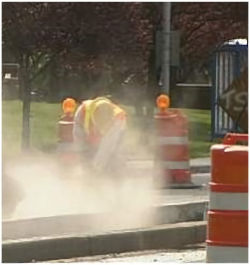Section 6 - Hazardous or Toxic Agents and Environments
06.A General.
06.A.01 Exposure standards.
Exposure, through inhalation, ingestion, skin absorption, or physical contact, to any chemical or biological agent in excess of the acceptable limits specified in the current American Conference of Governmental Industrial Hygienist (ACGIH) guideline, "Threshold Limit Values and Biological Exposure Indices"," published Department of the Army (DA) or Department of Defense (DoD) Exposure Limits, or by OSHA must be prohibited.
 The employer must not allow exposure in excess of established limits.
The employer must not allow exposure in excess of established limits.For the purpose of this document, the applicable standard is the Occupational Exposure Limit (OEL). Physical agents are addressed individually in this section.
- Note: For Beryllium, the Department of Energy's exposure value of 0.2 ug/m3 may be allowed with written permission from the HQUSACE-SO.
- In case of conflicts between ACGIH, OSHA, DoD or DA standards or regulations referenced in this manual, the more stringent must be used as the OEL.
- The employer must comply with all applicable standards and regulations to reduce contaminant concentration levels As Low As is Reasonably Achievable (ALARA).
- Activities where occupational exposure to a chemical or biological warfare agent is possible, must comply with current DA safety and occupational health requirements for chemical and biological agents.
- Activities involving ammunition and explosives or their constituents or chemical warfare agents may have additional requirements as specified in EM 385-1-97, Explosives Safety and Health Requirements Manual.
06.A.02 Hazard evaluation.
- Jobsite operations, materials, and equipment involving potential exposure to hazardous or toxic agents or environments must be evaluated by a qualified Industrial Hygienist, or equivalent competent person in Industrial Hygiene operations, to formulate a hazard control program. A description of the methods to be used must be accepted by the GDA or local Safety and Occupational Health Office (SOHO) before the start of the specific operation. > This evaluation must be performed at least annually for USACE operations.
- Activity Hazard Analysis (AHA) and/or Position Hazard Analysis (PHA) must be used to document the evaluation of the hazards and the controls present. The hazard evaluation must identify all substances, agents, and environments that present a health, explosive or fire hazard to workers or visitors, the risk of the hazard, and recommend hazard control measures. Engineering and administrative controls must be used to control hazards; in cases where engineering or administrative controls are not feasible, personal protective equipment (PPE) may be used.
- The hazard evaluation must document: the nature of the evaluation (air, biological or radiological samples, etc.); that it serves as certification of hazard evaluation; the workplace and activity evaluated; the name, position and credentials of the person certifying that the evaluation has been performed; any controls and training being utilized; and the date of the evaluation. This evaluation must be documented in a written report and available for review by the GDA or SOHO for USACE operations.
Knowledge Check Choose the best answer for the question.
6-1. Who must evaluate jobsite operations, materials, and equipment involving potential exposure to hazardous or toxic agents or environments?
You forgot to answer the question!
